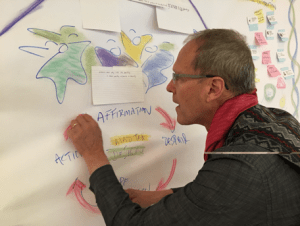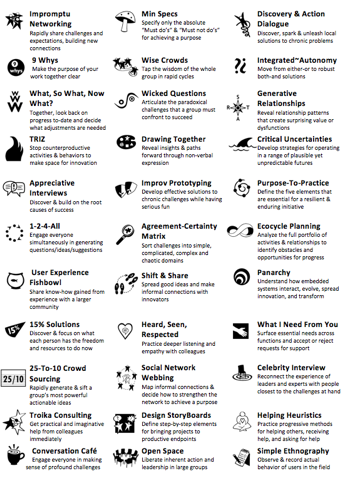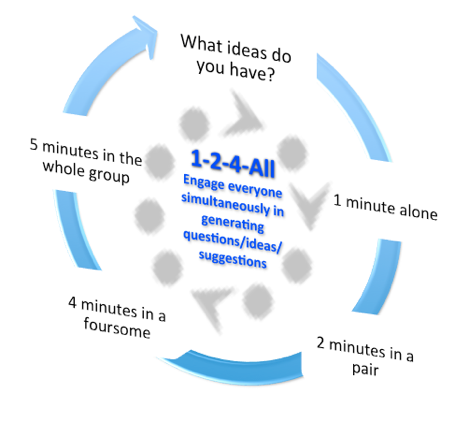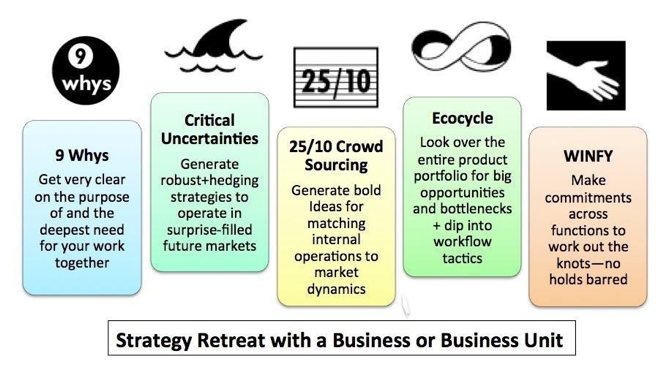By Henri Lipmanowicz and Keith McCandless
This post originally appeared on Medium on February 21, 2020. We are reposting a summarized version of it with Henri Lipmanowicz’s and Keith McCandless’ permission.

Liberating [verb]: to set free from imposed, controlling structures
Structures [noun]: simple rules that specify how people are included and participate

Based on our book, The Surprising Power of Liberating Structures (2013), Liberating Structures (LS) are simple change methods that anybody can use to improve or change the way work gets done, now and in the future. The LS repertoire consists of 33 practical methods versatile enough for anyone to use for a wide array of activities and challenges. Also, every single structure rests on the idea that everybody is included and invited to participate in shaping the group’s shared future. The structures are easy to learn, requiring no lengthy training. They are easy to use and don’t require bringing in an expert. Step-by-step descriptions for each are freely available on the website www.liberatingstructures.com. The LS App, available for both iOS and Android devices, means that one can literally carry the description of all 33 structures in one’s pocket. Since most LS take only 10 to 30 minutes they can fit easily within a normal work or meeting schedule.
Although every structure is precisely designed and described, they are all in fact quite “forgiving,” meaning that interesting and worthwhile results will emerge even when a structure is not “perfectly” implemented. Users report that, no matter what happens, the results are much more useful than what conventional structures would have produced. Participants enjoy being fully involved and engaged from beginning to end, they like the pace and the animation, the not-infrequent laughter.
Get notified when new articles are posted to the EDR blog – sign up for our email list »
Their power springs from the five design elements:
- The invitations: Are tightly connected to the purpose of each Liberating Structure but they leave all participants fully in control for generating responses and content.
- How participation is distributed: No artificial, a priori limit is imposed on the number of participants! EVERYBODY that is affected can ALWAYS be included and will get equal time and opportunity to contribute.
- How groups are configured: Most of the work is done is small groups, everybody working in parallel, then sharing results and moving forward in rapid cycles.
- Sequence of steps and timing: Work is broken down into easy chunks logically sequenced to achieve the stated purpose of the chosen structure.
- How space is arranged: The space where work gets done is usually fixed. This element defines how the space is shaped, modified, or adapted based on what is needed to best implement the chosen structure.
Example
For example, one of the most basic structures — called 1–2–4-All — is designed to generate and sift many ideas from group members in rapid cycles. It is an alternative to brainstorming and status reports and is often used within other Liberating Structures.

Structuring Invitation:
A question asking for ideas or proposals about an issue (e.g., What opportunities do YOU see for making progress on this challenge? What ideas or actions do you recommend? What questions do you have?)
How Participation Is Distributed:
Everyone is given an equal time and opportunity to participate
How Groups Are Configured:
Individual, pairs, groups of four, whole group (in this order)
How Space Is Arranged and Materials Needed:
4 chairs per table or groups of 4 chairs with no tables at all, notepads to record observations and insights
Sequence of Steps and Timing:
1–2 minutes: Silent self reflection on a shared challenge or issue (framed as a question)
2–5 minutes: Generate and share ideas in pairs
2–5 minutes: Share ideas from pairs in foursomes
5 minutes: Each group shares one important idea with all and meanings/conclusions are recorded
LS users quickly discover that it is possible, and not that difficult, to include and engage everybody and give everyone the opportunity to contribute. Surprising better-than-expected, results emerge; enthusiasm as well as ease of implementation follow. Plus, each experience jointly liberates more possibility and confidence in each other. When used alone, the 33 LS already cover a very wide range of purposes, from spreading ideas to developing strategies. But what makes LS truly powerful is the virtually infinite number of permutations that can be achieved by stringing them together. Strings provide alternatives not only for addressing any challenge but also make it possible to address complex problems that groups tend to neglect.

Progress with each structure builds on the previous one and informs the next piece of the complex puzzle. Everyone is connected, making unique contributions on worthy challenges and relying on one another to generate ideas. LS distribute control in a way that helps people transcend functional roles and positions. The gulf between the deciders and the doers narrows or disappears. The need for elaborate buy-in schemes and incentives after the fact fades away because participants jointly shaped the strategies. The traditionally small circle of strategists is replaced by a much wider one. Momentum arises from all voices authoring their future.
Liberating Structures are methods with a clear purpose: to improve personal and group performance. Anyone can easily learn and use at least a few of them. So let’s find ways to get LS into the drinking water and, as you do, take a sip, then a drink and see where that leads.
 Henri Lipmanowicz retired from Merck in 1998 after a 30-year career during which he progressed from Merck’s Managing Director in Finland to President of the Intercontinental Region and Japan (the world minus the US and Western Europe) and a member of Merck Management Committee. In 2000 Henri co-founded the Plexus Institute and served as Chairman of the Board until 2010.
Henri Lipmanowicz retired from Merck in 1998 after a 30-year career during which he progressed from Merck’s Managing Director in Finland to President of the Intercontinental Region and Japan (the world minus the US and Western Europe) and a member of Merck Management Committee. In 2000 Henri co-founded the Plexus Institute and served as Chairman of the Board until 2010.
Born in Carcassonne, France, Henri holds a MS degree in Industrial Engineering and Management from Columbia University and a MS degree in Chemical Engineering from France. His career gave him the opportunity to live in seven countries and made him a perpetual world traveler. He resides in the US with his Finnish wife; their joy in their seven grandchildren is beyond their wildest expectations. While in France he drives around in a 1961 2CV Citroen.
 Keith McCandless is the co-developer of Liberating Structures and co-author of The Surprising Power of Liberating Structures: Simple Rules to Unleash A Culture of Innovation (2013). He consults with business, government, philanthropic, research, educational, and health organizations worldwide, focusing on how to address complex challenges and include everyone in shaping the future.
Keith McCandless is the co-developer of Liberating Structures and co-author of The Surprising Power of Liberating Structures: Simple Rules to Unleash A Culture of Innovation (2013). He consults with business, government, philanthropic, research, educational, and health organizations worldwide, focusing on how to address complex challenges and include everyone in shaping the future.
Born in Cincinnati Ohio, he holds a Masters in Management of Human Services from Brandeis University in Boston and a BA from Evergreen State College in Olympia, Washington. Keith lives in Seattle with his wife, Annie, and Deacon the whippet with talent to amuse. Keith and Henri have worked as partners since 2002 to develop Liberating Structures.
